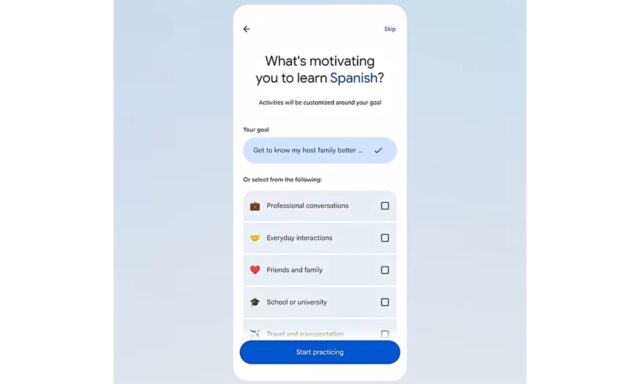Google Translate is ready to take on Duolingo with new language learning tools

When it comes to casual, mobile-based language learning, Duolingo reigns supreme. And now Google Translate is ready to take it on head-to-head.
Until now, Google Translate has been a multi-tool for travellers, holidaymakers, businesspersons and immigrants. It serves as an on-demand dictionary and translation tool for dozens and dozens of languages, and the next step sees it branching out into language lessons.
Duolingo need not be quaking in its boots – certainly not yet. After a period of beta testing with a relatively small audience, Google is unleashing its language learning tools in preview to a wider audience.
This is just one of two Google Translate announcements, the other being live translations powered by, you’ve guessed it, artificial intelligence. Google says of the new learning feature:
Google Translate is already a powerful tool for learning a new language. But we’ve heard from our users that the toughest skill to master is conversation — specifically, learning to listen and speak with confidence on the topics you care about. So today we’re piloting a new language practice feature designed to help you meet your unique learning goals.
Whether you’re an early learner looking to begin practicing conversation or an advanced speaker looking to brush up on vocabulary for an upcoming trip, Translate can now create tailored listening and speaking practice sessions just for you. These interactive practices are generated on-the-fly and intelligently adapt to your skill level.
At this stage, it is unlikely that Google Translate will become a replacement for the likes of Duolingo, but this is clearly something that Google has in its sights. The company is pushing not only ease of access, but also the personalized nature of its teaching methods as a way to differentiate it from the competition.
It says:
To start, just tap “practice” in the app, set your skill-level and goals, and Translate will generate customized scenarios for you to dive into. In each scenario, you can either listen to conversations and tap the words you hear to build comprehension, or you can practice speaking with helpful hints available when you need them. Developed with learning experts based on the latest studies in language acquisition, these exercises track your daily progress and help you build the skills you need to communicate in another language with confidence.
Google Translate levels up
Android and iOS users also have access to the AI-driven live translation capabilities. Google says:
We’ve introduced the ability to have a back-and-forth conversation in real time with audio and on-screen translations through the Translate app. Building on our existing live conversation experience, our advanced AI models are now making it even easier to have a live conversation in more than 70 languages — including Arabic, French, Hindi, Korean, Spanish, and Tamil.
To try it out, open the Translate app for Android or iOS, tap on “Live translate,” select the languages you want to translate and simply begin speaking. You’ll hear the translation aloud and see a transcript of your conversation in both languages on your device. Translate smoothly switches between the two languages you and your language partner are speaking, intelligently identifying conversational pauses, accents and intonations. This allows you to have a natural conversation with just a single tap.
To allow for use out in the wild, in the real world, Google has trained its models to isolate the vocals of people involved in the conversations, cutting out background noise and other chatter that may be audible.
Check out the video Google has produced to showcase the new capabilities:
As these are previews, they are not finished products and there may be issues – as such, it’s probably best not to rely on them for anything which is a matter of life and death.
